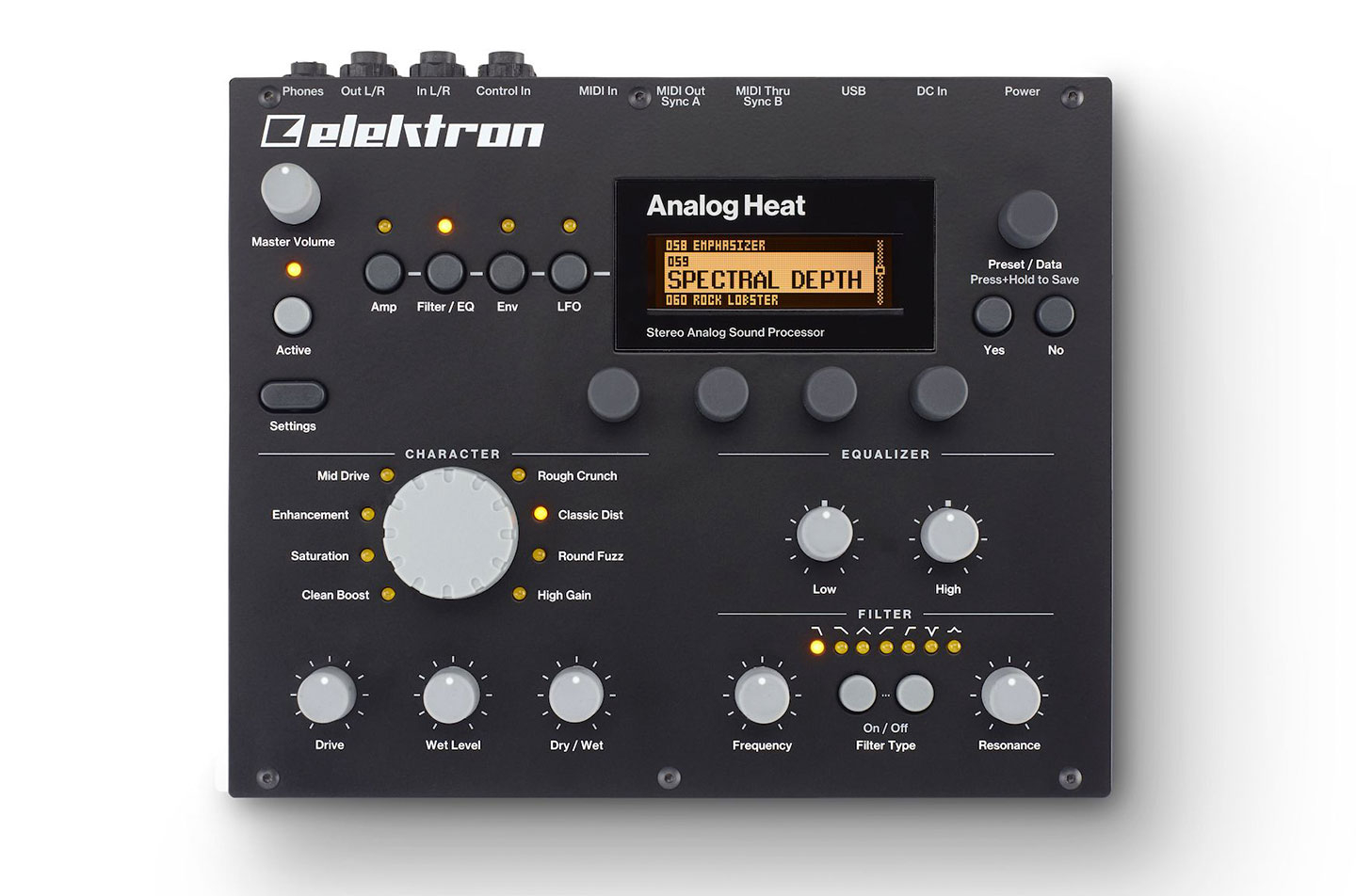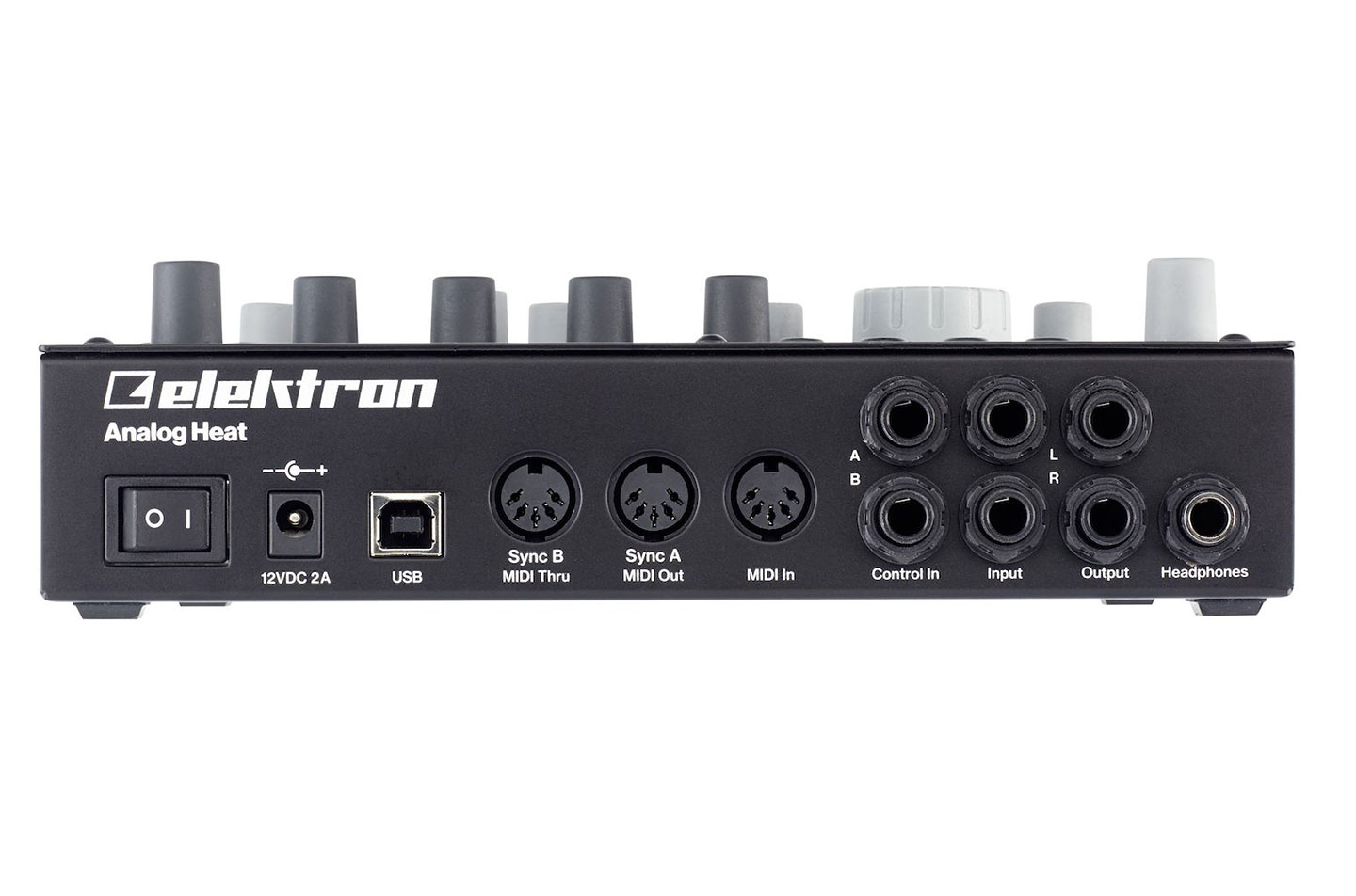- As an electronic musician, finding a high quality two-channel saturator/distortion unit that doesn't suck away the low end of your signal is not an easy task. There are plenty of good software solutions out there, but hardware options tend to be expensive boutique products like the Thermionic Culture Vulture or the Elysia Karacter, which are beyond the price range of many producers. If you were taking bets on which manufacturer would be the first to target this gap in the market, you might've guessed Strymon or Eventide. But a firm that few would have expected stepped up this past fall, when the Swedish instrument makers at Elektron revealed their very first dedicated effects box, the Analog Heat.
Elektron was careful to call the Analog Heat a "stereo sound processor" to avoid pigeonholing it as a distortion unit. With a look at the specifications, you can see why. Alongside eight distinct analog distortion/saturation circuits, it packs in a multi-mode filter, analog EQ, envelope generator/follower and an assignable LFO. The Analog Heat can also act as a two in/two out USB audio interface, while the effects can be bypassed for recording clean signals. Then you factor in support for Elektron's Overbridge technology—which lets you process audio from your DAW while simultaneously recording gear connected to the physical inputs—and it becomes clear that this is more than just a stereo distortion unit.
Having said that, distortion and saturation are the Analog Heat's bread and butter. The eight different circuits were designed to provide a wide range of tone shaping. Clean Boost is the subtlest option, sounding transparent at lower settings but mimicking old mixers when driven harder, while High Gain and Rough Crunch are among the more extreme flavours. Each circuit responds differently to various levels of drive—the best way to get a feeling for it is through experimentation. Elektron also has a great interactive demo on their site that lets you run six different types of audio though each circuit. One thing I noticed on the physical unit that you don't hear on the demo is a small but audible gap in audio when switching between the circuits. This might be bothersome in live situations, but you can get around it by turning the effect processing off temporarily with the Active button.
The two-band EQ boosts or attenuates at two fixed frequency points. Interestingly, Elektron customised the EQ's response and default curve to suit the individual distortion circuits, meaning each band responds differently depending on the chosen circuit. This is most clearly shown in Overbridge, where the EQ curve is one of many pieces of visual feedback that helps you understand what the Analog Heat is doing to your audio signal. It would have been nice to have control over the frequency of the low and high nodes here, but that doesn't mean the EQ isn't useful, especially in combination with the Heat's seven different filter modes.
Elektron products are known for their powerful modulation capabilities. Despite not having a sequencer and the power of parameter locks, the Analog Heat still has an impressive amount of power under the hood. The LFO and envelope generator/follower can be combined with modulation from expressions pedals or control voltages via a pair of inputs on the back of the unit. You can configure those sources to modulate pretty much anything, including the parameters of the LFO and envelope follower, an option that should make the Analog Heat very attractive to modular owners.
The feature that really pushes the Analog Heat to the next level is its compatibility with Overbridge. I've already mentioned some of its highlights, such as the visual feedback and ability to simultaneously process external and internal audio sources, but there are more benefits provided by this integration. Simplified preset management and parameter automation are two of the more obvious ones, but perhaps the most powerful aspect of the Overbridge plug-in is support for mid/side processing. This allows you to treat the centre part of your signal separately from the sides rather than just processing left and right as separate channels. In the Analog Heat plug-in you can choose to process either the mid, the sides or both. Unfortunately, you can't have unique settings for the two channels like you can on more expensive units such as the Elysia Karacter. Oddly enough, this feature is only available when using the Overbridge plug-in—you can't enable it from the hardware when using it in standalone mode.
Overall, I was really impressed with the Analog Heat. It has its share of quirks, and the screen isn't the greatest (especially compared to the OLED Elektron has put on the recently-announced Digitakt) but it packs in enough versatility to easily make it worth the price of admission. It can be a subtle mastering tool, a vicious distortion, a dedicated audio interface and a DAW-automatable effects unit all in one compact package.
Ratings:
Cost: 4.0
Versatility: 4.8
Ease of use: 4.0
Sound: 4.6
Build Quality: 4.2
 Elektron products are known for their powerful modulation capabilities. Despite not having a sequencer and the power of parameter locks, the Analog Heat still has an impressive amount of power under the hood. The LFO and envelope generator/follower can be combined with modulation from expressions pedals or control voltages via a pair of inputs on the back of the unit. You can configure those sources to modulate pretty much anything, including the parameters of the LFO and envelope follower, an option that should make the Analog Heat very attractive to modular owners. The feature that really pushes the Analog Heat to the next level is its compatibility with Overbridge. I've already mentioned some of its highlights, such as the visual feedback and ability to simultaneously process external and internal audio sources, but there are more benefits provided by this integration. Simplified preset management and parameter automation are two of the more obvious ones, but perhaps the most powerful aspect of the Overbridge plug-in is support for mid/side processing. This allows you to treat the centre part of your signal separately from the sides rather than just processing left and right as separate channels. In the Analog Heat plug-in you can choose to process either the mid, the sides or both. Unfortunately, you can't have unique settings for the two channels like you can on more expensive units such as the Elysia Karacter. Oddly enough, this feature is only available when using the Overbridge plug-in—you can't enable it from the hardware when using it in standalone mode. Overall, I was really impressed with the Analog Heat. It has its share of quirks, and the screen isn't the greatest (especially compared to the OLED Elektron has put on the recently-announced Digitakt) but it packs in enough versatility to easily make it worth the price of admission. It can be a subtle mastering tool, a vicious distortion, a dedicated audio interface and a DAW-automatable effects unit all in one compact package. Ratings: Cost: 4.0 Versatility: 4.8 Ease of use: 4.0 Sound: 4.6 Build Quality: 4.2
Elektron products are known for their powerful modulation capabilities. Despite not having a sequencer and the power of parameter locks, the Analog Heat still has an impressive amount of power under the hood. The LFO and envelope generator/follower can be combined with modulation from expressions pedals or control voltages via a pair of inputs on the back of the unit. You can configure those sources to modulate pretty much anything, including the parameters of the LFO and envelope follower, an option that should make the Analog Heat very attractive to modular owners. The feature that really pushes the Analog Heat to the next level is its compatibility with Overbridge. I've already mentioned some of its highlights, such as the visual feedback and ability to simultaneously process external and internal audio sources, but there are more benefits provided by this integration. Simplified preset management and parameter automation are two of the more obvious ones, but perhaps the most powerful aspect of the Overbridge plug-in is support for mid/side processing. This allows you to treat the centre part of your signal separately from the sides rather than just processing left and right as separate channels. In the Analog Heat plug-in you can choose to process either the mid, the sides or both. Unfortunately, you can't have unique settings for the two channels like you can on more expensive units such as the Elysia Karacter. Oddly enough, this feature is only available when using the Overbridge plug-in—you can't enable it from the hardware when using it in standalone mode. Overall, I was really impressed with the Analog Heat. It has its share of quirks, and the screen isn't the greatest (especially compared to the OLED Elektron has put on the recently-announced Digitakt) but it packs in enough versatility to easily make it worth the price of admission. It can be a subtle mastering tool, a vicious distortion, a dedicated audio interface and a DAW-automatable effects unit all in one compact package. Ratings: Cost: 4.0 Versatility: 4.8 Ease of use: 4.0 Sound: 4.6 Build Quality: 4.2